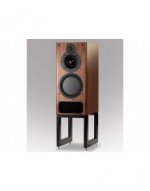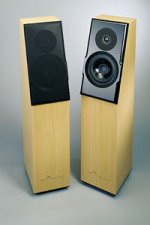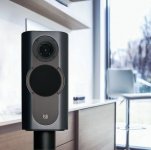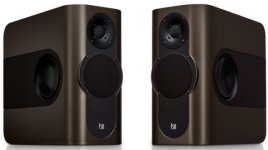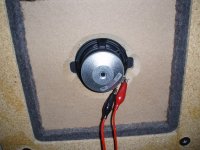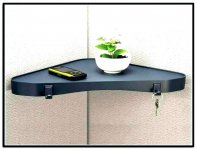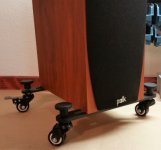..do you think there is any advantage to go to the AXP-10 if I can fit them ?
None other than max spl.. and in several respects worse.
Note that the Dayton and Gradient midbass drivers are coated linen ..
Other parts of the driver will fail long before these surrounds will. (..though that's not to say that glue from diaphragm to surround won't fail - that's more likely for any dynamic driver).
Last edited:
An idea for design with the basic elements so far:
Rectangular loudspeaker cabinet on short-rise open-frame stand with spikes up to cabinet and down to floor (..8 spikes per stand). ..sort of like the PMC speaker seen below on its stand, but with a much shorter stand and a taller loudspeaker cabinet (and twin ports at the bottom that are probably 1/3rd the height of the PMC).
One of the more fundamental elements of the design here is an open-cavity (void) for the tweeter and midrange that encompasses the top 1/3rd of the cabinet. I'm not even sure if this will work for your design, but it shouldn't be difficult to mock-up in cardboard and measure. For visuals - look to Dan's Echelon loudspeaker, particularly with regard to the midrange (..which is just open in the rear):
Introducing: Echelon -
Techtalk Speaker Building, Audio, Video Discussion Forum
These dimensions are guesses
Exterior Cabinet dimensions:
Cabinet height = 92 cm
Cabinet width = 25 cm
Cabinet depth = ..about 55 cm
Ports integrated into the bottom of the loudspeaker cabinet exiting front baffle (again, bottom of it): about 3.8 cm by 8.9 cm (side-by-side). Port length should be close to 35 cm.
-I'm expecting some diffraction "gain" (bump) somewhere between 400 and 1.5 kHz relative to the average for the midrange that will need correction/incorporation into the crossover. ..and something close to an 89 db average for the loudspeaker itself.
Short-rise open-frame stand dimensions including spikes:
Stand + Spikes height = 20 cm; the frame itself is probably around 15 cm in height.
Driver placement on baffle:
Tweeter centered (horizontally) just above the frame of the midrange.
Midrange centered (horizontally) at 72 cm from bottom of cabinet. (..the center of the midrange itself should be at 72 cm.)
Midbass centered (vertically and horizontally) at 30 cm from bottom of cabinet.
-that's about 35 cm between the top of the midbass and the bottom of the midrange.
-the midbass frame's bottom is about 40 cm off of the floor with the loudspeaker on its stand.
Interior Void for midrange AND tweeter: (..an open-back "tunnel" as in the Echelon's midrange volume)
Void spans the entire width of the interior of the cabinet, and from the cabinet's top panel - down 30 cm. Lossy padding about 8 cm thick on both sides and top + bottom interior panels of the void - except only about 4 cm thick padding for the sides near both drivers (about 20 cm from front baffle to rear).
I use Bonded Logic "UltraTouch" recycled denim insulation rolls for acoustic-absorption. This stuff:
https://www.homedepot.com/p/UltraTo...tion-Roll-16-in-x-48-in-60301-16482/202709974
Rectangular loudspeaker cabinet on short-rise open-frame stand with spikes up to cabinet and down to floor (..8 spikes per stand). ..sort of like the PMC speaker seen below on its stand, but with a much shorter stand and a taller loudspeaker cabinet (and twin ports at the bottom that are probably 1/3rd the height of the PMC).
One of the more fundamental elements of the design here is an open-cavity (void) for the tweeter and midrange that encompasses the top 1/3rd of the cabinet. I'm not even sure if this will work for your design, but it shouldn't be difficult to mock-up in cardboard and measure. For visuals - look to Dan's Echelon loudspeaker, particularly with regard to the midrange (..which is just open in the rear):
Introducing: Echelon -
Techtalk Speaker Building, Audio, Video Discussion Forum
These dimensions are guesses
Exterior Cabinet dimensions:
Cabinet height = 92 cm
Cabinet width = 25 cm
Cabinet depth = ..about 55 cm
Ports integrated into the bottom of the loudspeaker cabinet exiting front baffle (again, bottom of it): about 3.8 cm by 8.9 cm (side-by-side). Port length should be close to 35 cm.
-I'm expecting some diffraction "gain" (bump) somewhere between 400 and 1.5 kHz relative to the average for the midrange that will need correction/incorporation into the crossover. ..and something close to an 89 db average for the loudspeaker itself.
Short-rise open-frame stand dimensions including spikes:
Stand + Spikes height = 20 cm; the frame itself is probably around 15 cm in height.
Driver placement on baffle:
Tweeter centered (horizontally) just above the frame of the midrange.
Midrange centered (horizontally) at 72 cm from bottom of cabinet. (..the center of the midrange itself should be at 72 cm.)
Midbass centered (vertically and horizontally) at 30 cm from bottom of cabinet.
-that's about 35 cm between the top of the midbass and the bottom of the midrange.
-the midbass frame's bottom is about 40 cm off of the floor with the loudspeaker on its stand.
Interior Void for midrange AND tweeter: (..an open-back "tunnel" as in the Echelon's midrange volume)
Void spans the entire width of the interior of the cabinet, and from the cabinet's top panel - down 30 cm. Lossy padding about 8 cm thick on both sides and top + bottom interior panels of the void - except only about 4 cm thick padding for the sides near both drivers (about 20 cm from front baffle to rear).
I use Bonded Logic "UltraTouch" recycled denim insulation rolls for acoustic-absorption. This stuff:
https://www.homedepot.com/p/UltraTo...tion-Roll-16-in-x-48-in-60301-16482/202709974
Attachments
Last edited:
Thanks ScottG for the very precise information's,
This is the what I have been working on based on your design, not sure if I did get the vents right or the tunnel for the Mid/High
The vented box volume for the Gradient is lower than the 70l (vb: 58.85,total: 64.24 total, it has been reduced from the total of the cabinet to separate that tunnel (it seem quiet big)
Also the parts to make the vents take some space in the volume (made with the same MDF (18mm)
Also I can't round the edges with the 8" that close from the edge



Please let me know if you see something wrong in my interpretation
This is the what I have been working on based on your design, not sure if I did get the vents right or the tunnel for the Mid/High
The vented box volume for the Gradient is lower than the 70l (vb: 58.85,total: 64.24 total, it has been reduced from the total of the cabinet to separate that tunnel (it seem quiet big)
Also the parts to make the vents take some space in the volume (made with the same MDF (18mm)
Also I can't round the edges with the 8" that close from the edge



Please let me know if you see something wrong in my interpretation
That's just about perfect ..well, assuming my guess's get you something workable. 
For volume you can extend the width just a bit (a few cm's), and most preferably extend the cabinet depth (the longer the better as far as an open mid is concerned, provided you've got sufficient acoustic absorption to handle any resonance issues). I tend to like a bit more volume (even with acoustic absorption), because of additions from panel dampers decreasing volume.
-round-over the edges except next to the woofer.. and you don't need to do it as you go lower either, though that's optional. Most especially you should have it at least 20 cm from *below the midrange's frame and up from there - including the top edge of the cabinet. ..see the baffle below.
*this is where you pick-up the most pressure from diffraction (the closer to the source, the greater), and even a modest round-over tends to reduce the resulting "oscillation" higher in freq..
Of course it's also missing "spot" bracing for the midbass cabinet portion, plus floating panel damping on the cabinet walls, and a suspended acoustic absorber, along with a suspended weight attached to the bottom of the cabinet with crossover housing.
 (..and the "spikes".)
(..and the "spikes".)
For volume you can extend the width just a bit (a few cm's), and most preferably extend the cabinet depth (the longer the better as far as an open mid is concerned, provided you've got sufficient acoustic absorption to handle any resonance issues). I tend to like a bit more volume (even with acoustic absorption), because of additions from panel dampers decreasing volume.
-round-over the edges except next to the woofer.. and you don't need to do it as you go lower either, though that's optional. Most especially you should have it at least 20 cm from *below the midrange's frame and up from there - including the top edge of the cabinet. ..see the baffle below.
*this is where you pick-up the most pressure from diffraction (the closer to the source, the greater), and even a modest round-over tends to reduce the resulting "oscillation" higher in freq..
Of course it's also missing "spot" bracing for the midbass cabinet portion, plus floating panel damping on the cabinet walls, and a suspended acoustic absorber, along with a suspended weight attached to the bottom of the cabinet with crossover housing.
Attachments
Last edited:
-I should also note that if you want to do a major round-over (..like the stuff from tapeease.com), that even though it requires extra width: the result would be superior. Something like their 3" Quarter Round (or larger). ..but it would likely make more of a visual "impact" in-room with that extra width.
You could even do it like Kii to keep width narrower - with its midbass proud of the round-over (..though the top edge isn't great with their design):
You could even do it like Kii to keep width narrower - with its midbass proud of the round-over (..though the top edge isn't great with their design):
Attachments
Though like much of the other additions I've mentioned: premature; this is something that should be noted:
Needs rear chamfer/bevel around drivers, most notably the midrange.
Ex.
Attachments
Thanks ScottG,
I am representing myself that design and I evaluate a few things from it :
55cm deep is already a bit pushing the limit for me, the Cabasse I have are 33cm and are 15cm from my back wall, I can't go more than 55 in depth but in width I can go to 32cm, but this is not advised as you remind me. In height 105cm is also slightly over but OK so far.
I am afraid that this high/mid tunnels will maybe not like to be close from the wall and I can't give more space. my left speaker is located in an angle
I'm a bit out of imagination concerning how that will behave in this case.
The lower part I can understand as it is a vented design.
So far I can represent the cabinet in Sketchup but the tool or myself show it's limit concerning integrating curves into one another, and I don't want to spend too much time creating something virtual it's only to give me an idea of what I will practically have to do with my hands after.
I have not represented the spikes on the model as it is too much work for me to do it, I am satisfy myself also with holes and no drivers in them
Now what I don't figure :
BTW I can find something a bit like that ultra-touch (funny name)in Belgium in 6cm thickness (sorry it's french) :
Metisse(R) isolant en laine de coton | Eurabo

Speaking of that I have no idea how I will pass the cabling or if I really should make a box for crossovers
BTW do you have any idea if it's possible to make that speaker with binding posts that allow me to choose between the passive-crossover or fully active three way ?
Speaking of my woodworking skill, I don't have two lefts hands and like to work with that material but I am clearly limited to basic (maybe a bit more )
)
I could maybe do that rounded edge and flush that driver into that to integrate it while keeping the width as it is.
No way I can do something as good as that Kii though or as the tapeease.com do
BTW when I looked at the website of tapeease I glimpsed "Denmark" and had some hope but then noticed its a place in Wisconcin, damn.
I will probably go in Vietnam for one month in around two weeks, so if don't answer much is not because I hide.
EDIT : Took note of that chamfer at the back of the drivers, you do good to remind me I would have not think of that.
I am representing myself that design and I evaluate a few things from it :
55cm deep is already a bit pushing the limit for me, the Cabasse I have are 33cm and are 15cm from my back wall, I can't go more than 55 in depth but in width I can go to 32cm, but this is not advised as you remind me. In height 105cm is also slightly over but OK so far.
I am afraid that this high/mid tunnels will maybe not like to be close from the wall and I can't give more space. my left speaker is located in an angle
I'm a bit out of imagination concerning how that will behave in this case.
The lower part I can understand as it is a vented design.
So far I can represent the cabinet in Sketchup but the tool or myself show it's limit concerning integrating curves into one another, and I don't want to spend too much time creating something virtual it's only to give me an idea of what I will practically have to do with my hands after.
I have not represented the spikes on the model as it is too much work for me to do it, I am satisfy myself also with holes and no drivers in them
Now what I don't figure :
I guess you mean internal mdf pannels with holes in them, if yes I have thought about this but failed to decide how many do I need in that volume, and do I keep using 18mm MDF ?"Spot" bracing
I have tried to think about what that can be but failed. (ghost panel?)Floating panel damping
I have imagined curtains of acoustic panel in the tunnel but refused to think that was itSuspended acoustic absorber
BTW I can find something a bit like that ultra-touch (funny name)in Belgium in 6cm thickness (sorry it's french) :
Metisse(R) isolant en laine de coton | Eurabo
Well that I visualizedSuspended weight attached to the bottom of the cabinet with crossover housing
Speaking of that I have no idea how I will pass the cabling or if I really should make a box for crossovers
BTW do you have any idea if it's possible to make that speaker with binding posts that allow me to choose between the passive-crossover or fully active three way ?
Speaking of my woodworking skill, I don't have two lefts hands and like to work with that material but I am clearly limited to basic (maybe a bit more
I could maybe do that rounded edge and flush that driver into that to integrate it while keeping the width as it is.
No way I can do something as good as that Kii though or as the tapeease.com do
BTW when I looked at the website of tapeease I glimpsed "Denmark" and had some hope but then noticed its a place in Wisconcin, damn.
I will probably go in Vietnam for one month in around two weeks, so if don't answer much is not because I hide.
EDIT : Took note of that chamfer at the back of the drivers, you do good to remind me I would have not think of that.
Last edited:
..I can't give more space. my left speaker is located in an angle
-a corner is BAD.
..probably have to do a more complex (chambered) re-design then, this would shrink depth and allow for an increase in volume.
I was thinking that if you needed to go near wall you could hang a silhouette (of your loudspeaker) 4" thick slab of mineral wool (with a fabric covering), but it doesn't sound as if you have enough space for that (..and you'd need at least 4" in front of that mineral wool for the rear of the loudspeaker).
This brings up a good question of how you place them in your room, and how you might place them, particularly if it's on a less permanent basis (..in other words: moving them for critical listening, and then putting them back when not).
A quick (limited) SketchUp model of your room and basic furniture positions would be helpful here, with intended listening position.
Last edited:
-a corner is BAD.
..probably have to do a more complex (chambered) re-design then, this would shrink depth and allow for an increase in volume.
I was thinking that if you needed to go near wall you could hang a silhouette (of your loudspeaker) 4" thick slab of mineral wool (with a fabric covering), but it doesn't sound as if you have enough space for that (..and you'd need at least 4" in front of that mineral wool for the rear of the loudspeaker).
This brings up a good question of how you place them in your room, and how you might place them, particularly if it's on a less permanent basis (..in other words: moving them for critical listening, and then putting them back when not).
A quick (limited) SketchUp model of your room and basic furniture positions would be helpful here, with intended listening position.
Sorry I should have started with that.
Yes it's not easy, hopefully one day I can move to a better place to work with but at the moment unfortunately I am constrained
This is the place I have to work with : (Notice how I work fast
EDIT : The Sofa is the place to be, and it's around 4 meters from the sound source, there is a few more things there but nothing taking more space

Last edited:
Now what I don't figure..
Speaking of my woodworking skill, I don't have two lefts hands and like to work with that material but I am clearly limited to basic (maybe a bit more)
I could maybe do that rounded edge and flush that driver into that to integrate it while keeping the width as it is.
No way I can do something as good as that Kii though or as the tapeease.com do..
Yeah, don't worry about that other stuff yet.. we aren't even close to getting to that.
Woodworking is largely down to the tools, and a bit of practice on scrap wood.
Anyone with a Youtube video search and a router with the right size round-over bit can do the routing in the 1st speaker I posted. I mean, it might take some practice before committing to the final baffle (practice-makes-perfect), but it shouldn't be difficult. Now having or getting access to the tools, that might take some extra effort/expenditure on your part.
The Kii look would pretty much require a supplier (*like Tapeease). Only large industrial router/planars are going to have access to a custom bit to do an actual round-over like that - and even then it's kind of a waste (..because it's a block of wood being rounded-over rather than something like the Tapeease). There are of course other ways to achieve that like a steam-and-bend on forms process, or doing multiple thin cuts to make the bend (and then filling-in the slots when done), or doing a stack-cut, or making a form and using a resin/cement, etc.. All to complex for this sort of build.
*of course you might be able to find such a supplier near you. Europe's got a lot of nice cabinet-grade material sources, and my guess is there is probably something like that available.
Last edited:
Yeah, don't worry about that other stuff yet.. we aren't even close to getting to that.
Woodworking is largely down to the tools, and a bit of practice on scrap wood.
Anyone with a Youtube video search and a router with the right size round-over bit can do the routing in the 1st speaker I posted. I mean, it might take some practice before committing to the final baffle (practice-makes-perfect), but it shouldn't be difficult. Now having or getting access to the tools, that might take some extra effort/expenditure on your part.
The Kii look would pretty much require a supplier (*like Tapeease). Only large industrial router/planars are going to have access to a custom bit to do an actual round-over like that - and even then it's kind of a waste (..because it's a block of wood being rounded-over rather than something like the Tapeease). There are of course other ways to achieve that like a steam-and-bend on forms process, or doing multiple thin cuts to make the bend (and then filling-in the slots when done), or doing a stack-cut, or making a form and using a resin/cement, etc.. All to complex for this sort of build.
*of course you might be able to find such a supplier near you. Europe's got a lot of nice cabinet-grade material sources, and my guess is there is probably something like that available.
I am confident i can do the woodwork related to the actual design, I may have access to a CNC but I am not sure yet, if not I will just buy a router (défonceuse) and practice.
There must be are proper provider like Tapeease somewhere around but I have not found one like that, and if it is I'm afraid that it will not be equivalent to the providers in US.
I can fit the 55cm and move them forward on occasion, but let's be real I will probably sometimes be lazy or my tyrannic queen will frown upon that eccentricity
..The Sofa is the place to be, and it's around 4 meters from the sound source, there is a few more things there but nothing taking more space..
..err, no it isn't.
The place to be listening is in that chair facing the wall with the book-cases.
If you are "up to it" - casters on stands can work very well! (..the result will be very much worth it for critical listening.)
EDIT: ..and yeah, I realize that it will be infrequent.
Yeah, definitely the rock-wool treatment, but as free standing "L's" (shape from top > down), for both speakers. Floor-to-slightly above top of cabinet. At least 4" thick, and further into the room than the loudspeaker's baffle (probably a foot or so). Covered in a white? fabric; really - any color or pattern for your decor will work as long as it's fairly coarse in weave or thin-fabric (..ie. acoustically "transparent"). Kind of like a cubical corner panel seen below.. (remove corner shelf and replace with loudspeaker).
-with the 4 meters distance the design will need to lower the height of the midbass driver on the baffle some (..maybe 10-15 cm).
Attachments
Last edited:
You are joking right ?..err, no it isn't.
The place to be listening is in that chair facing the wall with the book-cases.
You mean I would put that small wheels on that cabinet stand and put spikes between the stands and the cabinets? I guess I would have to be really careful not to tip that, can't I use stuff like that instead ? :If you are "up to it" - casters on stands can work very well! (..the result will be very much worth it for critical listening.)
EDIT: ..and yeah, I realize that it will be infrequent.(..though the result may be so good that it becomes more frequent!)
An externally hosted image should be here but it was not working when we last tested it.
So covering the wall at the back of the cabinets with rockwool and the floor until it hit the stands ? You have any example in picture of the form it would take?Yeah, definitely the rock-wool treatment, but as free standing "L's" (shape from top > down), for both speakers. Floor-to-slightly above top of cabinet. At least 4" thick, and further into the room than the loudspeaker's baffle (probably a foot or so). Covered in a white? fabric; really - any color or pattern for your decor will work as long as it's fairly coarse in weave or thin-fabric (..ie. acoustically "transparent"). Kind of like a cubical corner panel seen below.. (remove corner shelf and replace with loudspeaker).
I'm afraid this could worst than moving my cabinets in the end but I reserve myself until I understand what you mean
-with the 4 meters distance the design will need to lower the height of the midbass driver on the baffle some (..maybe 10-15 cm).
Ha, that I can do!
EDIT: Nice corner shelf indeed, but what for ?
Last edited:
Not joking, I've been known to do this myself. 
You know, casters:
casters - Google Search
Total cabinet height needs to be the same, so subtract from stand height or place casters on outside of stand (..opposed to stand) like image below.
You know, casters:
casters - Google Search
Total cabinet height needs to be the same, so subtract from stand height or place casters on outside of stand (..opposed to stand) like image below.
Attachments
So covering the wall at the back of the cabinets with rockwool and the floor until it hit the stands ? You have any example in picture of the form it would take?
I'm afraid this could worst than moving my cabinets in the end but I reserve myself until I understand what you mean
EDIT: Nice corner shelf indeed, but what for ?
err, that's what the cubical paneling was intended to represent!
Needs to go floor to loudspeaker height +, and needs to extend further into the room than your loudspeaker. Loudspeaker 15 cm + away from panel sides. Two mirrored "L" panels; each louspeaker positioned in "corner" of panel.
Basically a short "false-wall" corner for each loudspeaker.
Last edited:
Not joking, I've been known to do this myself.
When I am on that side I can't clearly distinguish the sound from the left cabinet, but curiously I have noticed really the best position for me to listen to music is to sit on the floor at max two meters centered between the cabinets
Indeed google search is the first thing I did because couldn't identify the word caster at first, so OK crystal clear.You know, casters:
casters - Google Search
Total cabinet height needs to be the same, so subtract from stand height or place casters on outside of stand (..opposed to stand) like image below.
err, that's what the cubical paneling was intended to represent!
(..stupid shelf getting in the way of a perfectly good panel shot.)
Needs to go floor to loudspeaker height +, and needs to extend further into the room than your loudspeaker. Loudspeaker 15 cm + away from panel sides. Two mirrored "L" panels; each louspeaker positioned in "corner" of panel.
Basically a short "false-wall" corner for each loudspeaker.
Hooo ok you mean that kind of irregular surface at the back of that shelf
So to make sure, is this it ? :

So to make sure, is this it ? :


..but much *further into the room and not nearly as high (..about 10 cm above cabinet).
*your red line.
-it's not "structural": it won't stand-up by itself (..or with just a bit of help).
However, the 10 cm Rock (mineral) Wool is semi-rigid, so I'd use that for this application.
And yes, consider another panel - same size right *beside the panel that's already extending-out into the room), with a slider (bottom) to pull it forward. (..the "exterior" panel is the one that gets retracted, the "interior" near the loudspeaker stays where it is.)
*when it's pushed back to the wall it would look like 20 cm thick panel, retract it for double the length into the room (with a staggered but overall 10 cm thickness). It's also a good idea to do it this way because when the panel is retracted, it leaves an air-space for half of it's length between the panel and wall (for the panel near the side wall) - which helps with freq.s a bit below 250 Hz (..that's difficult to otherwise absorb) that's right in the corner of the room.
However, the 10 cm Rock (mineral) Wool is semi-rigid, so I'd use that for this application.
And yes, consider another panel - same size right *beside the panel that's already extending-out into the room), with a slider (bottom) to pull it forward. (..the "exterior" panel is the one that gets retracted, the "interior" near the loudspeaker stays where it is.)
*when it's pushed back to the wall it would look like 20 cm thick panel, retract it for double the length into the room (with a staggered but overall 10 cm thickness). It's also a good idea to do it this way because when the panel is retracted, it leaves an air-space for half of it's length between the panel and wall (for the panel near the side wall) - which helps with freq.s a bit below 250 Hz (..that's difficult to otherwise absorb) that's right in the corner of the room.
Last edited:
-with the 4 meters distance the design will need to lower the height of the midbass driver on the baffle some (..maybe 10-15 cm).
correction: this was "..back-asswards"; it's being closer where the first floor reflection occurs at a lower freq. (..which is bad).
Still, the lower (10-15 cm) midbass height is a good idea for a closer listening distance (..like if you pull them out for critical listening).
- Status
- This old topic is closed. If you want to reopen this topic, contact a moderator using the "Report Post" button.
- Home
- Design & Build
- Software Tools
- Advices on First Crossover Design (VituixCAD2)
